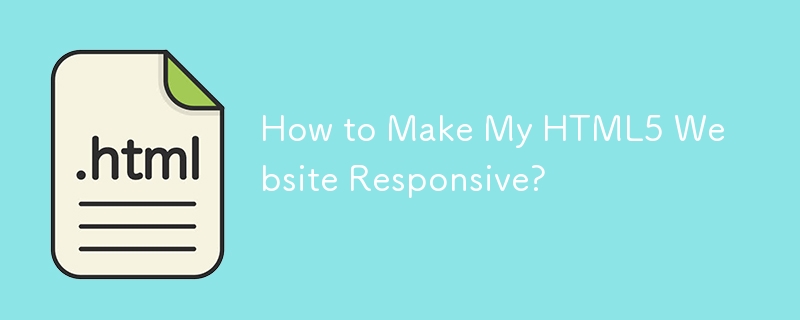Found a total of 10000 related content

How to Make My HTML5 Website Responsive?
Article Introduction:This article details creating responsive HTML5 websites. It emphasizes using viewport meta tags, flexible layouts (with relative units), CSS media queries, and responsive images. Various CSS frameworks (Bootstrap, Tailwind CSS, etc.) and testing me
2025-03-10
comment 0
431

How to make a responsive image gallery with HTML5?
Article Introduction:To create a responsive picture gallery, the core is to use HTML5 and CSS to achieve adaptation of structure and layout. 1. Use and semantic organization of image content; 2. Use CSSGrid or Flexbox for responsive layout, and Grid is recommended to automatically adjust the multi-column arrangement of the number of columns; 3. Set the image width 100%, adapt highly and use object-fit to maintain proportional filling; 4. Pay attention to details such as gap, minmax and alt attributes to improve aesthetics and accessibility.
2025-07-09
comment 0
646

How to use the HTML5 picture element for responsive images
Article Introduction:The core of using HTML5's picture elements to implement responsive pictures is to load the most suitable image resources according to the device characteristics. The specific methods are as follows: 1. The elements contain multiple and one, and the browser matches the conditions in order that meets the conditions, otherwise it will fall back; 2. Combining the srcset and sizes attributes, let the browser automatically choose the best size; 3. Prioritize loading of modern formats (such as WebP) by specifying the type attribute, and downgrade supporting traditional formats; 4. Pay attention to order, retain as fallback, consider compatibility and SEO optimization.
2025-07-05
comment 0
866

Using HTML5 Source Set for Responsive Images (srcset)
Article Introduction:How to implement responsive image loading on different devices? Use HTML5's srcset and sizes properties. The specific methods are: 1. Prepare pictures of multiple sizes and mark the width with w units; 2. Define the viewport ratio of pictures under different screen widths in sizes, such as (max-width: 600px)100vw; 3. Pay attention to setting DPR high-definition adaptation, such as 1x/2x descriptor; 4. Always keep src as a compatibility solution; 5. Plan the image size according to the device breakpoint, such as 480px/768px/1024px, etc.; 6. Test the loading effect of each size through the developer tool. This ensures that the browser accurately selects the best picture, taking into account loading speed and display quality.
2025-07-05
comment 0
434

How to Use Bannersnack to Generate Amazing Banners in Seconds
Article Introduction:Bannersnack: Design Stunning Responsive Banner Ads Without Coding
(This article is a sponsored collaboration with StudioWorks. Thank you for supporting our partners.)
Banner ads remain a cornerstone of online advertising, despite their long history
2025-02-15
comment 0
706

What are the best practices for HTML5 development?
Article Introduction:The article outlines best practices for HTML5 development, focusing on semantic HTML, responsive design, accessibility, and performance optimization. It also lists productivity tools and resources for staying updated with HTML5 standards.
2025-03-17
comment 0
1010

Using Device Orientation in HTML5
Article Introduction:HTML5 Device Orientation API: A Comprehensive Guide
This article explores the HTML5 Device Orientation API, a powerful tool for creating responsive web applications that react to a device's physical orientation. We'll cover its functionality, implem
2025-02-21
comment 0
876

Convert the below data into Tabular format in HTML5?
Article Introduction:Here is the converted data into a tabular format using HTML5, including examples and strategies for responsive design, best practices for styling, and semantic HTML5 tags used within a table structure:<!DOCTYPE html>
<html lang=&
2025-04-30
comment 0
911

How do I optimize HTML5 code for performance and accessibility?
Article Introduction:The article discusses optimizing HTML5 for performance and accessibility, focusing on code minimization, semantic elements, caching, and responsive design. Key tools for performance testing and accessibility practices are also covered.
2025-03-17
comment 0
963

How to Embed Images and Videos in HTML5?
Article Introduction:This article details embedding images (<img>) and videos (<video>) in HTML5. It covers tag attributes, responsive design using CSS, and optimization techniques for faster loading, including image/video compression, lazy
2025-03-10
comment 0
351

How Do I Style My HTML5 Website with CSS?
Article Introduction:This article explains HTML5 website styling using CSS. It covers linking CSS, writing styles, using selectors, and best practices for clean structure (e.g., preprocessors, naming conventions). Responsive design techniques like media queries and flu
2025-03-10
comment 0
331

How to Create a Drop-Down Nav Menu With HTML5, CSS3, and JQuery
Article Introduction:This tutorial demonstrates building a responsive dropdown navigation menu using HTML5, CSS3, and jQuery. We'll cover the HTML structure, CSS styling, and jQuery functionality to create a smooth and user-friendly experience.
Project Setup:
Create a
2025-03-04
comment 0
1182

An Introduction to the Genesis Framework
Article Introduction:Genesis Framework: A Deep Dive into WordPress Theme Excellence
The Genesis Framework, a highly regarded WordPress theme structure, stands out for its clean HTML5 and CSS3 coding, resulting in a lightweight, responsive, and SEO-friendly platform. Thi
2025-02-18
comment 0
836

Is H5 a Shorthand for HTML5? Exploring the Details
Article Introduction:H5 is not just the abbreviation of HTML5, it represents a wider modern web development technology ecosystem: 1. H5 includes HTML5, CSS3, JavaScript and related APIs and technologies; 2. It provides a richer, interactive and smooth user experience, and can run seamlessly on multiple devices; 3. Using the H5 technology stack, you can create responsive web pages and complex interactive functions.
2025-04-14
comment 0
1082

HTML5 Video and Audio: The Markup - SitePoint
Article Introduction:Detailed explanation of HTML5 video and audio tags: Building a responsive video player
This article is excerpted from the book "HTML5 & CSS3 for the Real World, 2nd Edition" co-authored by Alexis Goldstein, Louis Lazaris and Estelle Weyl. This book is available in major bookstores around the world, and you can also purchase the e-book version here.
Core points
HTML5's video and audio tags allow for embedded video and audio elements directly in HTML code, without the need for external plug-ins or players.
HTML5 video and audio tags contain multiple attributes to control the behavior of these elements, such as autoplay
2025-02-18
comment 0
339

Best practices for HTML5 and CSS3
Article Introduction:Web pages developed using HTML5 and CSS3 should follow semantic tags, reasonable layout, responsive design and compatibility processing. 1. Use semantic tags such as, etc. to improve structural clarity and SEO; 2. Use Flexbox to achieve one-dimensional layout, and Grid handles two-dimensional layout to avoid excessive nesting; 3. Set breakpoints through media queries to achieve responsive design, adopt mobile-first strategy; 4. Pay attention to browser compatibility, use CanIUse to check support, and combine Autoprefixer to add prefixes and provide fallback solutions.
2025-07-11
comment 0
163

Implementing Native Lazy Loading for HTML5 Images and Iframes
Article Introduction:How to implement lazy loading of images and iframes in HTML5? By adding loading="lazy" attribute to the and tags, the browser delays loading these elements until they are about to enter the viewport. Applicable scenarios include non-first-screen content at the bottom of the page, gallery or product pages with a large number of pictures, content skipped by mobile terminals in responsive design, and pages with multiple iframes embedded. It is not recommended to use lazy loading for key content on the home screen such as logo or banner. Notes include: 1. When it is compatible with old browsers, you must introduce polyfill; 2. Ensure that the search engine can recognize the image content to avoid SEO influence; 3. Set placeholders to prevent layout jitter; 4. Dynamically inserted pictures need to be manually processed and lazy loaded.
2025-07-07
comment 0
395

Embedding video content using the HTML5 `` tag.
Article Introduction:Embed web videos using HTML5 tags, supports multi-format compatibility, custom controls and responsive design. 1. Basic usage: add tags and set src and controls attributes to realize playback functions; 2. Support multi-formats: introduce different formats such as MP4, WebM, Ogg, etc. through tags to improve browser compatibility; 3. Custom appearance and behavior: hide default controls and implement style adjustment and interactive logic through CSS and JavaScript; 4. Pay attention to details: Set muted and autoplay to achieve automatic playback, use preload to control loading strategies, combine width and max-width to achieve responsive layout, and use add subtitles to enhance accessibility.
2025-07-07
comment 0
472

















